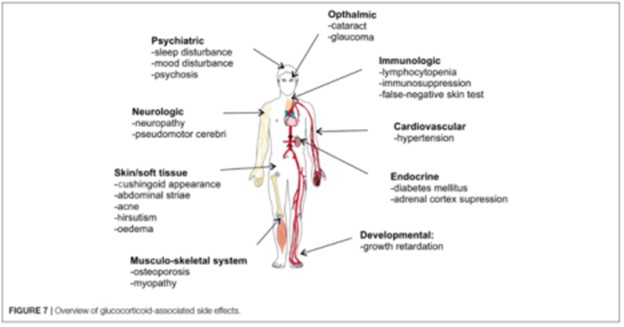What signs and symptoms are associated with a hypersensitivity reaction that can present with a Cephalosporin?
Skin rash
Hyperglycemia
Dizziness
Intense pruritus
Correct Answer : A,D
Signs and symptoms associated with a hypersensitivity reaction to cephalosporin antibiotics can include:
1. Skin rash: Hypersensitivity reactions often manifest as skin rashes, which can range from mild to severe. The rash may be itchy, red, raised, and may spread to different areas of the body.
2. Intense pruritus: Pruritus refers to severe itching, which can be a prominent symptom of a hypersensitivity reaction to cephalosporins.
Dizziness and hyperglycemia are not commonly associated with hypersensitivity reactions to cephalosporins. Dizziness may be a side effect of some medications, including antibiotics, but it is not a specific symptom of a hypersensitivity reaction. Hyperglycemia, or high blood sugar levels, is not typically attributed to a hypersensitivity reaction to cephalosporins. It's important to note that hypersensitivity reactions can vary in severity and may include other symptoms such as fever, swelling, difficulty breathing, wheezing, and anaphylaxis. If a hypersensitivity reaction is suspected, it is crucial to seek immediate medical attention for proper evaluation and management.
Nursing Test Bank
Naxlex Comprehensive Predictor Exams
Related Questions
Correct Answer is ["A","B","C","D","E","F"]
Explanation
Ensure the client receives adequate amounts of fluids: This is important to maintain hydration and thin respiratory secretions, making it easier for the client to cough and clear the airways. Check the client's mouth for stomatitis: Methylprednisolone can increase the risk of developing oral candidiasis (thrush) or stomatitis, which can cause discomfort and interfere with oral intake. Regular mouth checks can help identify these conditions early for appropriate management. Assess the client's mental status: Pneumonia, particularly in individuals with pre-existing lung disease like COPD, can lead to hypoxemia, which may affect mental status. It is important to monitor the client's mental status, as changes in cognition or confusion can be indicators of hypoxia and require prompt intervention.
Monitor for signs of hypokalemia: Methylprednisolone, like other corticosteroids, can cause electrolyte imbalances, including hypokalemia (low potassium levels). Hypokalemia can have various effects on the body, including muscle weakness and cardiac dysrhythmias. Regular monitoring of potassium levels and signs of hypokalemia is important for timely management. Monitor the client's blood glucose levels: Methylprednisolone can increase blood glucose levels, particularly in individuals with pre-existing diabetes or impaired glucose tolerance. Regular monitoring of blood glucose levels is necessary to ensure proper glycemic control and prevent hyperglycemia-related complications.
Monitor the client's blood pressure for hypotension: Corticosteroids like methylprednisolone can cause fluid retention, leading to an increase in blood pressure. However, sudden withdrawal of corticosteroids can result in adrenal insufficiency and hypotension. Close monitoring of blood pressure is necessary to identify any significant changes and adjust the medication regimen accordingly.

Correct Answer is ["A","B","C","D","E"]
Explanation
a. Considered primary treatment for small cell lung cancer (SCLC): Chemotherapy b. Used to prevent metastasis to the brain: Prophylactic cranial radiation
c. Electric current heats and destroys tumor cells: Radiofrequency ablation d. Best procedure for cure of lung cancer: Surgery
e. Medications that block molecules involved in tumor: Biologic and targeted
Whether you are a student looking to ace your exams or a practicing nurse seeking to enhance your expertise , our nursing education contents will empower you with the confidence and competence to make a difference in the lives of patients and become a respected leader in the healthcare field.
Visit Naxlex, invest in your future and unlock endless possibilities with our unparalleled nursing education contents today
Report Wrong Answer on the Current Question
Do you disagree with the answer? If yes, what is your expected answer? Explain.
Kindly be descriptive with the issue you are facing.
